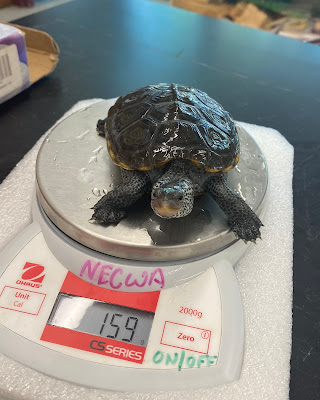Raising Swifty the baby Terrapin Hatchling
Last fall, Ben Squire and his students at Center School in Mattapoisett head started one of NECWA's terrapin hatchlings. This school-wide project was supported by the Mattapoisett Cultural Council. Ben and his students cared for the hatchling through the winter and into the early spring, when it was released back into its home marsh in early June. The students named this baby "Swiftie" for its quick swimming movements in its home tank.
Ben was able to work with all of the grades at Center School from Kindergarten through 4th Grade. Every day, Ben and his students cared for the terrapin hatchling, feeding the wee-one and cleaning its tank. Every week, they would collect some data on their turtle-friend by taking a few shell measurements and a weight. This basic data was used by the students to plot and tack the animal's growth over time and as material in many of their projects.
"The highlight of head starting a terrapin with the younger grade level students includes projects that focus on science, math, and ELA.
- Students in Kindergarten identified different adaptations of the terrapins that help them survive in the salt marshes.
- First Grade students studied the different types of turtles and had an introduction to the salt marsh ecosystem.
- Second Grade students created pins to raise awareness for habitat destruction and the impact of humans on the environment. Each student created 2-3 pins and they were made available at the school art show. Aboutt 200 pins were given to the public. They also studied maps to see how impacts have changed the amount of salt marshes over the last 100 years.
To accompany their drawings, some of the students wrote stories about terrapins and their habitats, like the one below from Zella, a Second Grader at Center School.
Save the Terrapins and Their Habitat
- Third Grade students made nest protect prototypes of out straws, possible sticks, and pipe cleaners. They also created a nest of eggs using model magic clay. These creations were also show n in the art show."
by Zella (Grade 2)
A salt marsh is a habitat along the coast
where many animals live. In the salt marsh
there are many animals such as the seahorse
and the diamondback terrapins. In the salt
marsh the most common plants are spartina
grass and cordgrass.
Diamondback terrapins live in the salt
marshes of Mattapoisett. Claws help them climb
and dig in the sand. Diamondback terrapins eat
small fish, small crabs and algae. Diamondback
terrapin predators are great blue heron,
seagulls, and foxes. They love the eggs.
The habitat of the diamondback terrapin has
been getting smaller over the last 100 years.
Terrapins live in the salt marshes. Humans
have been building houses on or near the salt
marshes. Humans should start to save terrapins
by protecting the salt marshes!
It was a fabulous effort by Ben and his students who really enjoyed raising their terrapin hatchling while learning about terrapins and their special habitats.











Comments
Post a Comment